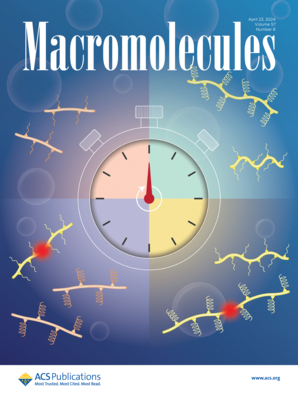Versatile Anisotropic Coarse-Grained Models for the Structure and Dynamics of Unentangled Poly(tetrafluoroethylene) Melt
IF 5.1
1区 化学
Q1 POLYMER SCIENCE
引用次数: 0
Abstract
We develop anisotropic coarse-grained (CG) models for unentangled poly(tetrafluoroethylene) (PTFE) melts to investigate their structural and dynamical properties at two CG levels, corresponding to six and eight CF2 groups per bead. Higher CG levels improve computational efficiency but face challenges, such as unphysical chain crossing due to reduced steric hindrance and weaker interactions. Additionally, the inherent chain stiffness of PTFE chains is evident. Analyses of the gyration tensor and asphericity indicate that structural anisotropy increases with CG levels. Therefore, we pursue a structure-based, bottom-up coarse-graining approach based on accurate all-atom (AA) simulations. Systematic probing of intermolecular interactions, internal conformations, and global chain dimensions reveals that our models effectively capture structural characteristics. Chain stiffness, such as the Kuhn length, agrees reasonably with AA simulations and experimental data. Furthermore, with appropriate scaling factors introduced, these CG models closely align with the atomistic counterpart in dynamics, including self-diffusivity and zero-shear viscosity. Assessments across molecular weights (48–192 carbons per chain) and temperatures (500 to 650 K) confirm the adaptability of these models. Utilizing the devised CG models, the computational efficiency is approximately accelerated by a factor of N2, where N is the number of CF2 groups per CG bead.

求助全文
约1分钟内获得全文
求助全文
来源期刊

Macromolecules
工程技术-高分子科学
CiteScore
9.30
自引率
16.40%
发文量
942
审稿时长
2 months
期刊介绍:
Macromolecules publishes original, fundamental, and impactful research on all aspects of polymer science. Topics of interest include synthesis (e.g., controlled polymerizations, polymerization catalysis, post polymerization modification, new monomer structures and polymer architectures, and polymerization mechanisms/kinetics analysis); phase behavior, thermodynamics, dynamic, and ordering/disordering phenomena (e.g., self-assembly, gelation, crystallization, solution/melt/solid-state characteristics); structure and properties (e.g., mechanical and rheological properties, surface/interfacial characteristics, electronic and transport properties); new state of the art characterization (e.g., spectroscopy, scattering, microscopy, rheology), simulation (e.g., Monte Carlo, molecular dynamics, multi-scale/coarse-grained modeling), and theoretical methods. Renewable/sustainable polymers, polymer networks, responsive polymers, electro-, magneto- and opto-active macromolecules, inorganic polymers, charge-transporting polymers (ion-containing, semiconducting, and conducting), nanostructured polymers, and polymer composites are also of interest. Typical papers published in Macromolecules showcase important and innovative concepts, experimental methods/observations, and theoretical/computational approaches that demonstrate a fundamental advance in the understanding of polymers.
 求助内容:
求助内容: 应助结果提醒方式:
应助结果提醒方式:


